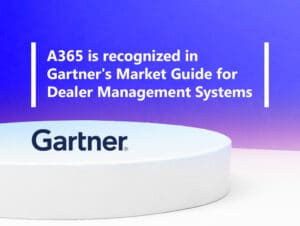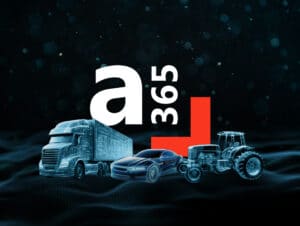Leveraging his extensive experience and recent discussions with equipment dealers from various brands, we sat down with István Herényi, Program Manager at Annata, to uncover the challenges and opportunities facing dealers like yours.
Join us as we delve into István’s perspectives on the evolution of Dealer Management Solutions (DMS), the advantages of cloud adoption, and the revolutionary impact of A365. His insights not only provide a comprehensive overview of the industry’s digital transformation journey but also serve as a guide for dealers looking to embrace technological advancements and thrive in a dynamic business environment.
1. Please tell us a little bit about yourself and your background.
I’m István Herényi, a Program Manager at Annata. I’ve been in the equipment industry for over 15 years, wearing many hats from solution architect to product architect and even Head of R&D. My journey has been all about crafting and implementing top-notch equipment solutions on the Microsoft platform, driving innovation and quality at Annata.
2. How do you see the DMS landscape for equipment dealers?
The landscape for equipment dealers can be broadly categorized into three groups:

a. Dealers with recently implemented solutions: These dealers are at an advantage, as they have a modern system that can scale with business needs and provide advanced functionalities. However, if this solution is an on-premise solution they will experience soon the difficulties to integrate with services available in the cloud.
b. Dealers with on-premise solutions implemented long ago: For these dealers, their system is likely reaching the end of its life cycle. They will need to consider upgrading or migrating to a more modern solution to avoid potential issues with system performance and support.
c. Dealers still using solutions on 30-year-old technology: Dealers in this category are likely facing significant challenges. Their outdated system is likely a bottleneck, making it difficult to maintain and integrate with modern technologies. These dealers should consider upgrading to a more current solution to improve efficiency and competitiveness.
Dealers in the last two categories now face urgent challenges and are essentially on a burning platform. Given the time required for selecting a new system and implementing it, they should start exploring their options now. I strongly recommend that they prioritize cloud-based solutions when looking for a new solution.
3. Why do you think moving to the cloud is a necessity for equipment dealers?
There are several general reasons for moving to the cloud, such as security, availability, uptime, and maintenance. However, the main reason, in my opinion, is the wealth of additional services available in the cloud and the ease with which they can be consumed.
This advantage is already significant today, and IT companies continually expand the range of tools and services available in the cloud. Companies that remain on-premise will struggle to
access and benefit from these services, ultimately falling behind. In my view, implementing an on-premise system in 2024 is like building a house without electricity 100 years ago.
4. Why do you think A365 is more future-proof than other solutions?
Rather than discussing available functionalities and how A365 provides an end-to-end solution for all business areas at an equipment dealership, I would like to highlight some of the directions we follow in our product development:

5. Could you please elaborate on your answer above?
a. Experience and best practices: With over 20 years in the market, we’ve worked with various brands in the equipment, trucks & buses, and automotive industries. This has helped us identify what works and what doesn’t. We’ve embedded best practices into our product based on these experiences.
b. Future focus: While we’ve incorporated current industry requirements into our product, we also look ahead to anticipate what will be needed in 5 to 10 years. We aim to align our product with future industry trends.
c. Process-oriented approach: Rather than focusing solely on individual features, we emphasize understanding and improving dealer processes. Our goal is to support, measure, and enhance these processes.
d. The best tool for the purpose: We need to satisfy two very different requirements: On one hand, we need to support complex business processes and guarantee consistency. On the other, end users demand an intuitive, simple User Interface. To reconcile the apparent contradiction between supporting complex business processes while meeting end users’ demands for an intuitive interface, we leverage the full range of Microsoft tools. Our solution is built on Azure for a solid, scalable, and flexible platform. We use Dynamics 365 Finance and Supply Chain as the core to handle complex processes and support parts and inventory management, accounting, finance, rental, and service. For end users, we offer an intuitive front-end, often accessible on mobile devices, leveraging Power Platform applications and Microsoft Customer Engagement.
e. Use standard: We’ve observed many heavily customized systems, which can become rigid and costly to maintain, especially in today’s rapidly changing environment. To avoid this, we align our system as closely as possible with Microsoft standards. This approach allows us to leverage Microsoft’s investments in release management. Customers who also keep their Dynamics 365 environment as standard as possible can benefit from the additional release effort we invest in each new release.
f. Data model and integration: As previously mentioned, I firmly believe that the greatest advantage of the cloud is that a system can be easily integrated with other cloud services. In several cases, the best way to achieve it is not on the application but on the data platform and the key success factor is a robust data model that can be understood by other applications and that can support the business. This data model could not only serve the applications and integrations but with some lighter transformations, it can also be used for BI purposes.
6. You had meetings with some equipment dealers lately could you mention some topics they were interested in?
Certainly! Let me share some examples
a. Many dealers have businesses beyond equipment or a specific brand and are interested in whether our solution can support these operations. The answer is yes. Annata focuses on three industries: Automotive, trucks & buses, and equipment, which means that our solution is designed to support these businesses. By leveraging Microsoft’s Dynamics 365 as our foundation, we can also support other businesses such as regular wholesale, retail, and manufacturing. Since we don’t overwrite standard features, industries supported by standard Dynamics 365 are automatically covered.
b. While A365 has CRM and Field Service capabilities, dealers who have already implemented such solutions may wonder if they can keep them and set up integration. The answer is once again, yes. We can integrate with existing solutions. However, this approach results in a more complex and rigid architecture compared to using A365 for all features. We’re continuously enhancing our product, and these enhancements will automatically be available for our A365 users.

c. Dealers were interested in accessing legacy data. By having our solution in the cloud built on a robust data model, it is possible to transform legacy data into our data model and load it into more cost-effective storage. Leveraging the capabilities of the Power Platform facilitates the development of apps that can consume both legacy and current production data and can be accessed even on a mobile device.
Interested in a personalized consultation with one of our industry experts to discuss your equipment business’s specific needs? Reach out to us here to schedule a session tailored to your requirements.









